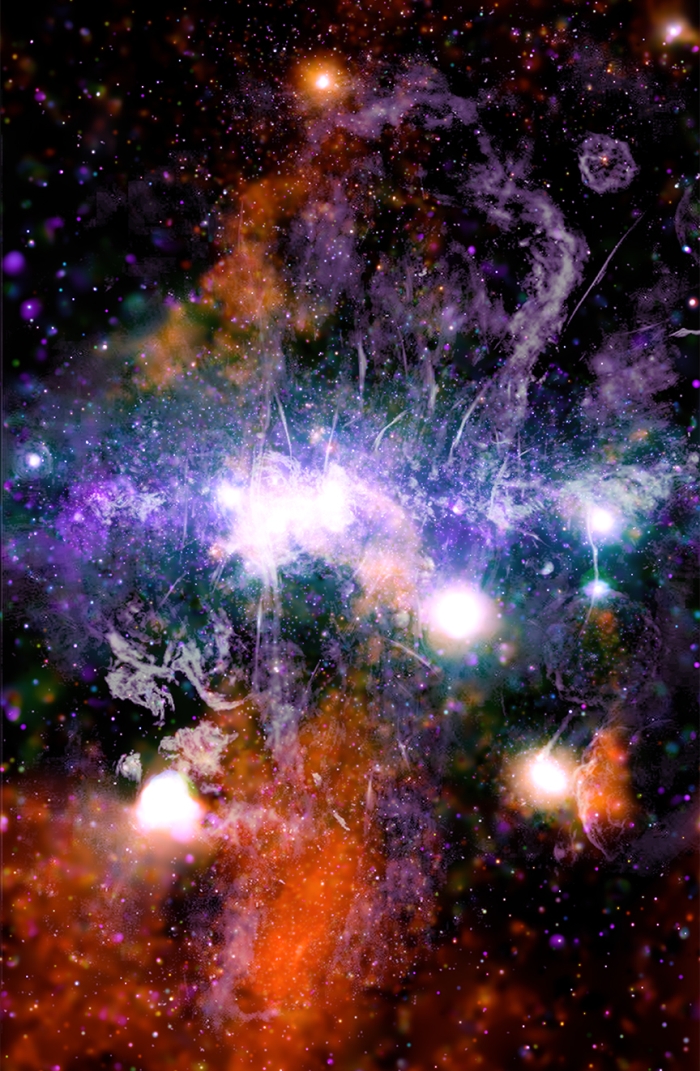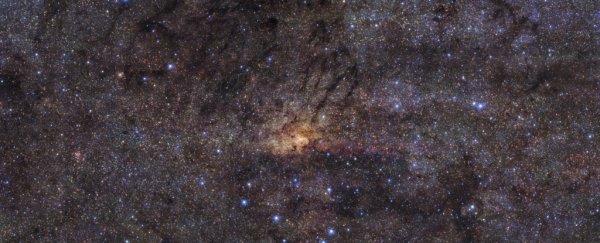The center of the Milky Way is a strange and wild place.
There dwells our galactic nucleus - a supermassive black hole 4 million times the mass of the Sun, a beast named Sgr A*. It's probably the most extreme environment in our galaxy, dominated by Sgr A*'s gravitational and magnetic fields.
It's also very hard to see into, even though it's only 25,800 light-years away: The region is shrouded by thick clouds of dust and gas that obscure some wavelengths of light. But if we use technology to tweak our vision into the invisible wavelengths, beyond the narrow capabilities of our eyes, we can begin to see some of the strange processes taking place therein.
Using the powerful Chandra X-ray Observatory space telescope and the MeerKAT radio telescope, astronomers have given us just such a view. They have combined these images for a panoramic mosaic that shows superheated gas threads and magnetic fields in "unprecedented" detail.
And, in a new paper, astronomer Daniel Wang of the University of Massachusetts Amherst has described these features in detail - including one particularly intriguing thread that glows brightly in both X-ray and radio wavelengths, intertwined.
"This thread reveals a new phenomenon," Wang said. "This is evidence of an ongoing magnetic field reconnection event."
 (NASA/CXC/UMass/Q.D. Wang; NRF/SARAO/MeerKAT)
(NASA/CXC/UMass/Q.D. Wang; NRF/SARAO/MeerKAT)
The entire image is fascinating. X-radiation is depicted in orange, green, blue and purple, representing different energies, and the radio wavelengths in gray and lilac. Above and below the galactic plane, two huge plumes of gas extend 700 light-years.
The southern one appears to be associated with the giant radio bubble only just discovered in 2019, thought to be the result of recent activity by Sgr A* (not to be confused with the much larger Fermi bubbles or eROSITA bubbles).
The fascinating gas thread, named G0.17-0.41, appears in the southern lobe - a long, slender structure 20 light-years long, but only 0.2 light-years wide.
The X-radiation is embedded within a radio filament, and its profile suggests that radio filament is a magnetic field. The shape and spectral properties of these associated elements suggest that the thread is the result of magnetic reconnection - a violent event that occurs when magnetic field lines aligned in opposite directions collide, break apart, and reconnect.
 G0.17-0.41. (NASA/CXC/UMass/Q.D. Wang; NRF/SARAO/MeerKAT)
G0.17-0.41. (NASA/CXC/UMass/Q.D. Wang; NRF/SARAO/MeerKAT)
During this process, which rearranges the magnetic field, magnetic energy is converted into kinetic energy and heat. Usually, though, this process isn't energetic enough to produce X-rays - but magnetic fields in the galactic center are much more powerful.
The filaments' location on the edges of the bubbles suggests that the magnetic reconnection may be triggered by collisions between clouds of gas. As material is pushed away from the outburst at the galactic center, it collides with gas in the interstellar medium, which in turn triggers the reconnection.
This could be partially responsible for heating the gas in the region, and suggests some interesting implications. Because most reconnection events will be too faint, or too diffuse in X-rays to be detected by our current methods, it's likely that G0.17-0.41 represents "only the tip of the reconnection iceberg in the galactic center," Wang wrote in his paper.
Because reconnection events may play a role in heating interstellar plasma, the acceleration of cosmic rays, interstellar turbulence and the formation of interstellar structures, he believes that filaments like G0.17-0.41 may be an excellent laboratory for understanding the physics of interstellar magnetic reconnection.
"The galactic center is a truly complex system, involving not only interplay among various stellar and interstellar components, plus Sgr A*, but also inflows and outflows, multiple energy sources, as well as heating and cooling mechanisms," he wrote.
"A comprehensive study of the galactic center with this complexity will require truly a multi-wavelength approach, together with dedicated theoretical and computer simulations. Ultimately, what we learn from the GC ecosystem and its connection to larger scale structures will provide us with insights into the working of similar extreme regions in other galaxies."
The research has been published in the Monthly Notices of the Royal Astronomical Society.
